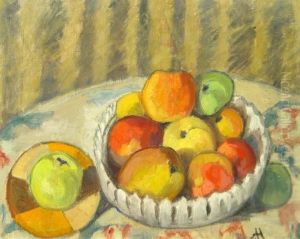Alice Haarburger Paintings
Alice Haarburger was a German Jewish photographer and graphic artist born on October 25, 1891, in Stuttgart, Germany. She emerged as a creative figure in the Weimar Republic, a period marked by a flourishing cultural scene and significant contributions to the modernist movement. Despite the progressive artistic environment of the time, Haarburger's life and career were tragically affected by the rise of the Nazi regime in Germany.
After completing her studies at the Stuttgart Academy of Art, Haarburger furthered her education in Munich and later in Berlin, where she was exposed to the burgeoning world of photography. She worked with renowned figures such as László Moholy-Nagy, a prominent professor at the Bauhaus school, whose teachings likely influenced her style and approach to art and photography.
Haarburger's work combined elements of New Objectivity and functionalist design, capturing the interplay between light and shadow, the geometry of the urban environment, and the candid moments of everyday life. Her eye for detail and composition reflected the modernist ethos of the time, and she was among the women artists who contributed to the development of photography as a form of artistic expression.
Unfortunately, the rise of National Socialism in Germany brought Haarburger's career to an abrupt halt. As a Jew, she faced persecution under the Nazi regime. Her work was deemed 'degenerate,' and she was barred from practicing her profession. In 1942, during the height of World War II, Alice Haarburger was deported to the Riga Ghetto in Latvia, where she was ultimately murdered by the Nazis. Haarburger's death on February 26, 1942, marked the loss of a talented artist whose potential and further contributions to the world of photography and graphic arts were cut short by the atrocities of the Holocaust.
The legacy of Alice Haarburger has been somewhat overshadowed by the tragic circumstances of her life and the era's tumultuous history. Yet, through the rediscovery and preservation of her remaining work, Haarburger's art continues to speak to us, offering a glimpse into the vibrant cultural landscape of the Weimar Republic and serving as a poignant reminder of the countless artists whose voices were silenced during World War II.
